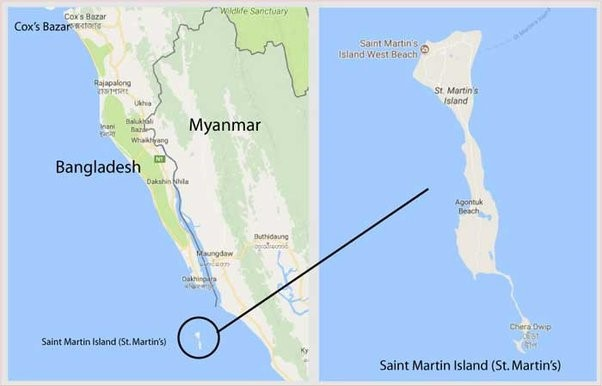- Courses
- GS Full Course 1 Year
- GS Full Course 2 Year
- GS Full Course 3 Year
- GS Full Course Till Selection
- Answer Alpha: Mains 2025 Mentorship
- MEP (Mains Enrichment Programme) Data, Facts
- Essay Target – 150+ Marks
- Online Program
- GS Recorded Course
- Polity
- Geography
- Economy
- Ancient, Medieval and Art & Culture AMAC
- Modern India, Post Independence & World History
- Environment
- Governance
- Science & Technology
- International Relations and Internal Security
- Disaster Management
- Ethics
- NCERT Current Affairs
- Indian Society and Social Issue
- NCERT- Science and Technology
- NCERT - Geography
- NCERT - Ancient History
- NCERT- World History
- NCERT Modern History
- CSAT
- 5 LAYERED ARJUNA Mentorship
- Public Administration Optional
- ABOUT US
- OUR TOPPERS
- TEST SERIES
- FREE STUDY MATERIAL
- VIDEOS
- CONTACT US
St Martin’s Island and Sheikh Hasina’s Controversy
St Martin’s Island and Sheikh Hasina’s Controversy
16-08-2024

St Martin’s Island, a unique coral island in the Bay of Bengal, has recently been at the center of a political controversy involving former Bangladesh Prime Minister Sheikh Hasina.
- Allegations that Hasina considered giving away the island to maintain her power have sparked public and political debate. This controversy has drawn attention to the island’s significance and its historical context.
Details:
-
Sheikh Hasina’s Statement:
- Sheikh Hasina’s Statements: Former Prime Minister Hasina claimed she could have stayed in power by giving the island to the US and mentioned an offer for an airbase. These claims have been denied by her son and the US State Department.
- Original Speech: The claim may be related to a 2023 speech where Hasina mentioned that while leasing out the island could be a way to maintain power, she would not do so. In her speech, the former prime minister also accused the opposition party, the Bangladesh Nationalist Party (BNP), of wanting to sell the island. She said, “How did the BNP come to power in 2001? They came to power by pledging to sell gas. Now do they want to sell the country or come to power by pledging to sell St Martin’s Island?”
-
St Martin’s Island:

-
- Location: Situated in the northeastern part of the Bay of Bengal, near the Bangladesh-Myanmar border, approximately 9 km from the Cox’s Bazar-Teknaf peninsula.
- Size and Features: The island is 7.3 km long and has an average elevation of 3.6 meters above sea level. It is the only coral island in Bangladesh, known for its coral reefs and as a breeding ground for sea turtles.
- Population and Tourism: The island supports a permanent population of about 10,000 people and attracts around 10,000 tourists daily.
-
Historical Background:
- Geological History: The island was once part of the Teknaf peninsula but submerged around 5,000 years ago. It began to resurface approximately 450 years ago, with the remaining parts emerging in the following century.
- Early Settlements: Arab traders settled there in the 18th century, initially naming it “Jazira” and later “Narikel Jinjira” (Coconut Island). During British rule, it was annexed in 1900, and Bengali and Rakhine fishermen were already residing there.
- Post-Colonial Changes: After the 1947 partition of British India, the island became part of Pakistan and then Bangladesh following the 1971 Liberation War.
- Legal Status: Bangladesh’s sovereignty over the island was confirmed by a 1974 agreement with Myanmar and reaffirmed by the International Tribunal for the Law of the Sea (ITLOS) in 2012.
-
Strategic Military Importance:
- Geopolitical Value: St Martin’s Island’s location near the Strait of Malacca, a major maritime trade route, makes it strategically valuable. A military base on the island could offer significant surveillance capabilities over the Bay of Bengal and monitor Chinese activities in the region.
- Regional Influence: Control of the island could provide oversight of trade routes and military movements, enhancing a country’s strategic position in South Asia.
-
Economic and Environmental Contributions:
- Economic Value: The island is within Bangladesh’s Exclusive Economic Zone (EEZ), granting access to marine resources like fish, oil, and gas. It is also a popular tourist destination known for its beaches and cultural heritage.
- Environmental Importance: The island’s coral reefs and marine life are crucial for conservation efforts, making it an important environmental asset.
-
Maritime Boundary Disputes:
- Contentious Area: The island’s proximity to Myanmar has led to maritime disputes. Despite the 2012 ITLOS ruling, Bangladeshi fishermen have faced challenges from Myanmar’s naval forces.
- Rohingya Crisis: The influx of Rohingya refugees from Myanmar has heightened security concerns around the island, with reports of insurgent groups attempting to claim it.
-
Potential US Interests:
- Strategic Goals: The US’s interest in the island is seen by some as part of a strategy to counter China’s influence in South Asia. There have been unconfirmed reports about the US proposing a military base or lease of the island.
- Regional Reactions: A US presence on the island could impact relations with neighboring countries like India and China. It could serve as a counterbalance to Chinese investments and potentially affect Indian shipping routes.
Implications:
-
Geopolitical Impact: The potential for US involvement highlights the island’s strategic importance in regional power dynamics. While the US has denied plans to acquire the island, its strategic value and the surrounding controversies underscore its significance in South Asian geopolitics.
-
Political Tensions: The dispute surrounding Hasina’s alleged statements and the opposition’s purported plans highlight ongoing political tensions in Bangladesh. The controversy illustrates the high stakes involved in managing national resources and sovereignty.
-
Public Impact: The situation has intensified public and political interest in St Martin’s Island, underscoring its strategic importance and the broader issues of national integrity and resource management.
Conclusion: St Martin’s Island’s strategic location and economic value make it a significant asset in regional politics. Although there are claims about US interest, both the US and Bangladeshi officials deny any plans involving the island. The situation highlights the island's importance in broader geopolitical and economic discussions.
Must Check: Best IAS Coaching In Delhi
UPSC Prelims Result 2024 Out: Expected Cut Off & Other Details, UPSC Prelims 2024 Answer with Explanation, Daily Prelims Quiz, Daily Current Affairs, MONTHLY CURRENT AFFAIRS TOTAL (CAT) MAGAZINE, Best IAS Coaching Institute in Karol Bagh, Best IAS Coaching Institute in Delhi, Daily Mains Question Answer Practice, ENSURE IAS UPSC Toppers, UPSC Toppers Marksheet, Previous Year Interview Questions, UPSC Syllabus




